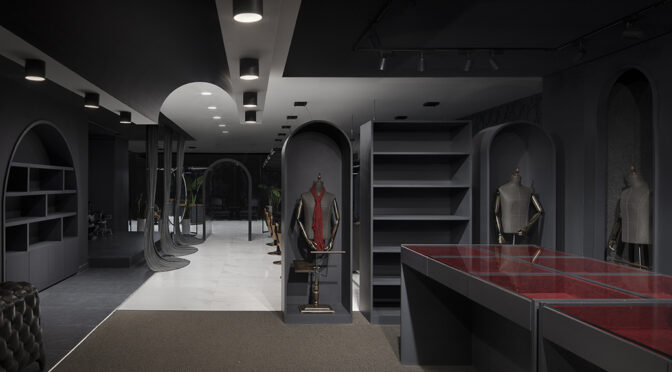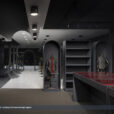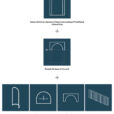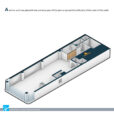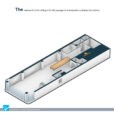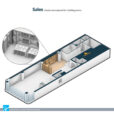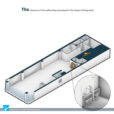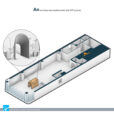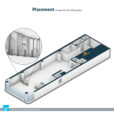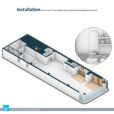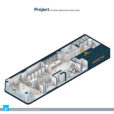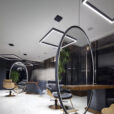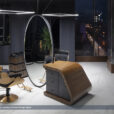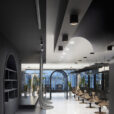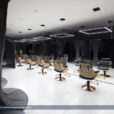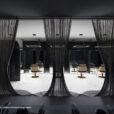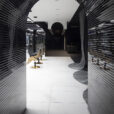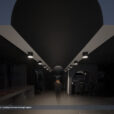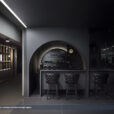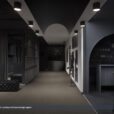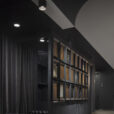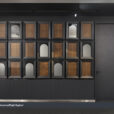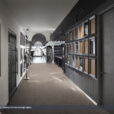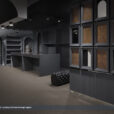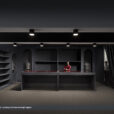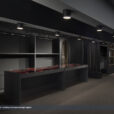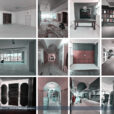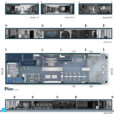پاتوق آقایان
محمدتقی باقری
موقعیت: مشهد، ایران
تاریخ: ۱۴۰۱
مساحت: ۴۰۰ مترمربع
وضعیت: ساختهشده
کارفرما: محمود عبدالهی، آرین محسنی
همکاران پروژه: ساره پورقربان، حسین علیزاده، محسن مولایی، زهرا شمسآبادی، سمانه علیپور، محمد پزشکیان، محمدجواد موحد
مشاور پروژه: محسن اکبرزاده
مبلمان: ژوگلان
عکس: استودیو نیمکت
سفارشدهنده پروژه از سال ۱۳۷۷ وارد حرفه آرایشگری شده و در آستانه دهه سوم فعالیتش، تاکنون هشت سالن مختلف را تجربه کرده بود. تیم معماری بر اساس تحلیل نیازهای ایشان و نیز مشتریان، طرحی فراتر از یک سالن آرایشگاه را پیشنهاد کرد؛ فضایی اختصاصی برای آقایان به منظور ریلکس و ریکاوری خستگی ناشی از کار روزانه. از آنجایی که طراحی یک کلوپ مختص آقایان نیاز به فضایی یکپارچه در یکی از باکیفیتترین محلات شهری داشت، با همفکری کارفرما، سالنی بزرگ در طبقه چهارم یک مجتمع نوساز تجاری در یکی از مناطق لوکس مشهد اجاره شد.
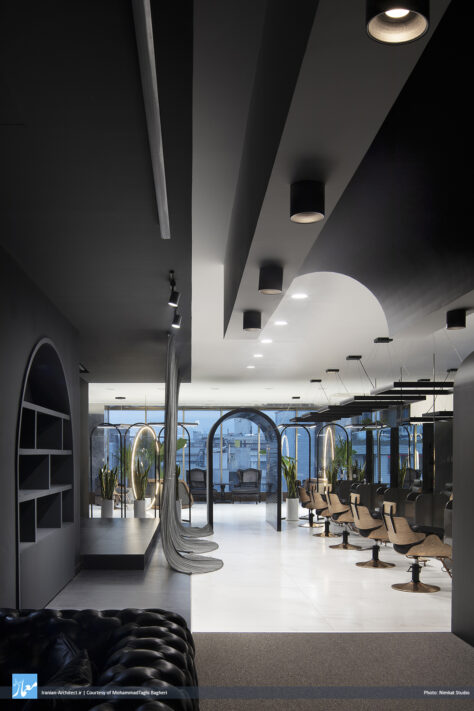
محدودیت مالی و نبود امنیت خاطر از حضور بلندمدت در ساختمان جدید، و نیز عدم موافقت مالک مجتمع برای ایجاد تغییرات اساسی در فضا، پروژه را به سمت تغییر حداقلی در ساختار فضا، و طراحی دکورهای انعطافپذیر با سیاست استفاده مجدد در فضاهای آینده سوق داد، بهگونهای که طرح قابلیت جابهجایی راحت و آسیب حداقلی در زمان استفادههای آتی را داشته باشد. از اینرو، ساختار کلی المانها با ترکیب چوب، فلز و شیشه شکل گرفت. همچنین به منظور آشنابودن فرمها در ذهن مخاطب، از گسترش و تکرار طاق در طرح استفاده شد که در ابعاد و ساختارهای مختلف، انسجام فرمی و ترکیببندی فضا را شکل داده است.
برنامه فیزیکی و سناریوی پروژه با توجه به محدودیتهای عملکردی و خدماتی، و نیز تاکید بهرهبردار بر یکپارچه دیدهشدن فضا، طراحی را به سمت ایجاد یک مفصل ارتباطی بین حوزههای عملکردی و خدماتی جهت داد که این امر از یکسو منجر به ایجاد یک کیفیت فضایی ویژه و منحصربهفرد تحت عنوان مسیر نمایش ایونتمحور لباس آقایان شد، و از سوی دیگر، خواسته کارفرما مبنی بر وجود دید مستقیم به منظر شهری در بدو ورود به مجموعه، و نیز دسترسی راحت و سلسلهمراتبی مراجعهکننده به خدمات موجود را برطرف کرد.
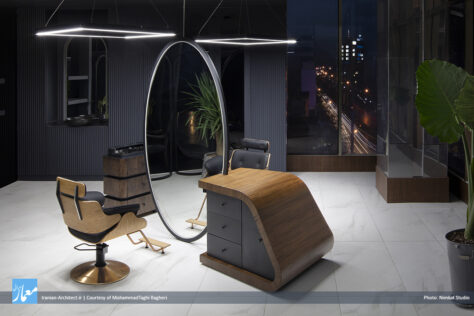
یکی از اهداف اصلی طرح، منطقهبندی هوشمند فضا بود، بهگونهای که هم مشتریان و هم کارمندان در فضایی واحد احساس راحتی داشته باشند، و در عینحال، خدمات با بهترین کیفیت و به سهولت ارائه شود. از اینرو، پلان در شش بخش عملکردی و خدماتی طراحی شد:
۱. پذیرش در دو حوزه اختصاصی داماد در بدو ورود، و فضای انتظار در نزدیکترین محل به مفصل ارتباطی مجموعه
۲. فضای اختصاصی فروش لباس، و مشاوره و فروش محصولات بهداشتی آقایان در مجاورت فضای انتظار و سالن اصلی آرایشگاه
۳. سالن عمومی و اصلی آرایشگاه در مجاورت فضای فروش و در مقابل فضای خدماتی شستشو و خدمات مانیکور و پدیکور
۴. فضای گریم و پیرایش داماد در شاهنشین و در مجاورت منظر شهری، با ورودی تعریفشده
۵. فضای مجزای ماساژ و پاکسازی در ضلع جنوبی سالن، به دلیل نیاز به آرامش و آسایش
۶. فضای اداری و مدیریت در بدو ورود و مجاور فضای پذیرش
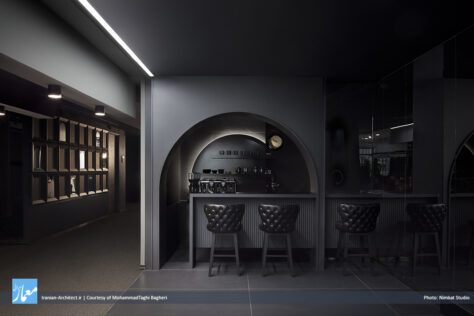
طراحی فضای انتظار مجموعه تلاشی بوده است برای ایجاد حس تعلق به مکان و ترغیب مشتریان به مراجعه مجدد و نیز به اشتراکگذاشتن این حس با دیگران. این فضا در نقطه عطف پروژه طراحی شده است و بهواسطه آیینههای پیرامونیاش میتواند به تمامی نقاط مجموعه تسلط و دید داشته باشد. مشتری در زمان انتظار میتواند بر روی یک مبلمان راحت، جلو یک صفحه نمایش ۸۰ اینچی لش کرده یا با سایر مراجعهکنندگان پلیاستیشن بازی کند، و یا پس از سفارش نوشیدنی مورد علاقهاش از بار کافیشاپ، به گفتگو یا تماشای برنامههای تلویزیون بپردازد یا در اتاق سیگار از منظر بیرونی شهر لذت ببرد.
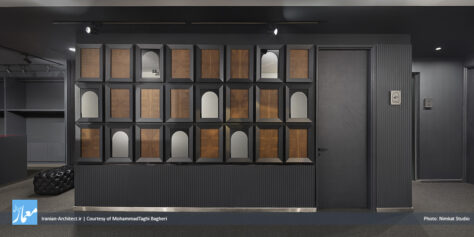
مجموعهای از فرمهای شاخص و المانهای تاثیرگذار با ترکیببندی مبتنی بر تناسبات طلایی، زوایای دید مخاطب را در تمامی فضاهای پروژه، بدون ایجاد مزاحمت شکل دادهاند:
ـ ۲۴ قاب در ورودی، به نشانه ۲۴ سال فعالیت؛ و ۸ آیینه با الهام از ۸ فضای قبلی کار؛ و یک تکقاب بزرگ در فضای انتظار، به نشانه ورود به دورهای جدید از زندگی حرفهای کارفرما
ـ پرده دستبافت از مفتول گالوانیزه فلزی نرم؛ استعاره از زره جنگی مردان شرقی، تور لباس عروس و موهای بلند آقایان در گذشته
ـ المان شاخص ساباط در ورودی بخش ویژه مجموعه، با آیینهکاری خشتچین در ابعاد ۳ و طول ۲۱۰ سانتیمتر؛ استعاره از دالانهای قدیم معماری گذشته
ـ ۷ طاق قوسی مازگونه، جداکننده فضای سالن آرایشگاه از فضای شاخص و شاهنشین؛ استعاره از پنجدریهای شاهنشین معماری گذشته و فضاهای نیمهشفاف معماری ایرانی
ـ تاج طاق معلق در مسیر ارتباطی فضاهای خدماتی؛ استعاره از گذار معماری گذشته به معماری پیشرو و آینده
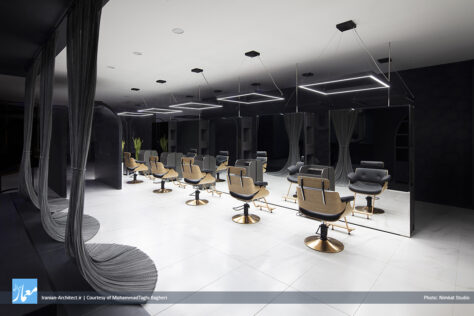
تفکیک فضا با تغییر مصالح در کف و تغییر رنگ در سقف؛ آیینهکاری در فضا برای ایجاد ارتباط بصری بین فضاها و عناصر مختلف؛ استفاده آگاهانه از اعداد پایه معماری سنتی ایران، یعنی ۳، ۵ و ۷ در فضا؛ و استفاده از رنگ طوسی برای از بینبردن سایه و طبیعی نشاندادن چهره و پوشش، و نیز دیدهنشدن موریزههای فضا، از مهمترین نکات و جزئیات مورد توجه در طراحی بوده است. همچنین فضای سبز در بخشهای مختلف سالن تعبیه شده و طراحی نورهای فضا به نحوی است که سایه بر روی مشتری در حال اصلاح سر نیفتد تا خطای کار آرایشگر به حداقل ممکن برسد.
Men’s Club
MohammadTaghi Bagheri
Location: Mashhad, Iran
Date: 2022
Area: 400 sqm
Status: Completed
Client: Mahmood Abdollahi, Arian Mohseni
Project Team: Sareh Pourghorban, Hossein Alizadeh, Mohsen Molaei, Zahra Shamsabadi, Samaneh Alipour, Mohammad Pezeshkian, Mohammad Javad Movahhed
Project Advisor: Mohsen Akbarzadeh
Furniture: Juglanwood
Photo: Nimkat Studio
The client of the project has been in the hairdressing profession since 1998, and on the verge of turning the third decade of his activity, he had worked at eight different salons. Based on the analysis of their needs as well as customers, the architectural team proposed a proposal surpassing the average barbershop; A dedicated space for men to relax and recover from daily work fatigue. Since the design of a men’s club required an integrated space in one of the most high-quality urban neighborhoods, with the client’s agreement, a large hall was rented on the fourth floor of a newly built commercial complex in one of the luxury areas of Mashhad.
The financial limitation and lack of assurance of long-term presence in the new building, as well as the complex owner’s refusal to make fundamental changes in the space, led the project towards a minimal change in the structure of the space, and the design of flexible decors with a reuse policy in future spaces, in a way that the plan has easy portability and have minimal damage during future assembling. Therefore, the overall structure of the elements was formed by combining wood, metal and glass. Also, in order to engage the audience’s mind, a familiar form was selected and the expansion and repetition of the arch was used in the design, which has shaped the formal coherence and composition of the space in different dimensions and structures.
The physical program and the design scenario, considering the functional and service limitations, as well as the user’s emphasis on an open and unified space, directed the design team towards creating a connection joint between the functional and service areas. On the one hand, this response led to the creation of a special and unique spatial quality, namely a men’s clothes display path which served as an event, and on the other hand, it met the client’s demand for a direct view to the city view upon entering the complex, as well as easy and hierarchical access for the customer to the available services.
One of the main goals of the plan was the intelligent zoning of the space, so that both customers and employees feel comfortable in a single space, and at the same time, the highest quality of services to be easily accessible. Therefore, the plan was designed in six functional and service departments:
1. Reception in two exclusive areas for the groom upon arrival, and the waiting area in the closest place to the connection joint of the space
2. A dedicated space for selling men’s clothes, and consulting and selling men’s hygiene products, in the vicinity of the waiting area and the main salon of the hairdressing
3. The public and main hall of the hairdressing, adjacent to the sales area, and in front of the washing and manicure and pedicure services area
4. The groom’s makeup space in the VIP salon, and in the vicinity of the city view, with a defined entrance
5. A separate space for massage and cleansing, on the south side of the hall, due to the need for peace and comfort
6. The management space at the entrance, and adjacent to the reception area
The design of the waiting area of the complex has been an effort to create a sense of belonging to the place, and encourage customers to visit again and share this feeling with others. This space has been designed at the turning point of the project. The waiting area is designed so that customers who enter, can see all the services of the complex by mirrors strategically placed there. While waiting, the customer can relax on a comfortable piece of furniture, in front of an 80-inch screen, play games with other customers, order a favorite drink and watch a TV show. Customers can also enjoy the outside view of the city in the smoking room, by ordering from the coffee shop bar.
A series of indicative forms and impressive elements with a composition based on golden proportions, have shaped the viewing angles of the audience in all the spaces without interruptions:
– 24 frames at the entrance, as a sign of 24 years of activity; and 8 mirrors inspired by 8 previous work spaces; and a large single frame in the waiting area, as a sign of the client entering a new era of his career
– Handwoven curtains made of soft galvanized metal wire; A metaphor for eastern men’s battle armor, wedding dress lace and men’s long hair in the past
– Sabat’s signature element at the entrance of the VIP salon, with mirror work in dimensions of 3 cm and 210 cm long; A metaphor from the old corridors of past architecture
– 7 arches separating the hairdressing salon from the VIP space; A metaphor of Panjdari rooms of the past architecture and the semi-transparent spaces of Iranian architecture
– The crown of the hanging arch in the access path of the service spaces; A metaphor from the transition of past architecture to progressive and future architecture
The separation of the space was done by changing the flooring materials and the ceiling’s color. Mirror work was introduced in the space allowing for visual connection between different elements, and creating a connection between the environments. Furthermore, there was a conscious use of basic numbers of traditional Iranian architecture 3-5-7 in the space. The grey color was used to eliminate the natural shadow, and it was chosen so that trimmed hair would be less visible. Special attention to lighting was taken, and the lights were placed in such a way to prevent shadows from obscuring the customer’s face while having their hair cut, so that the error of the hairdresser’s work is minimized. Lastly, green space was installed in different parts of the hall.

